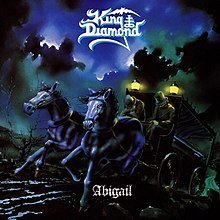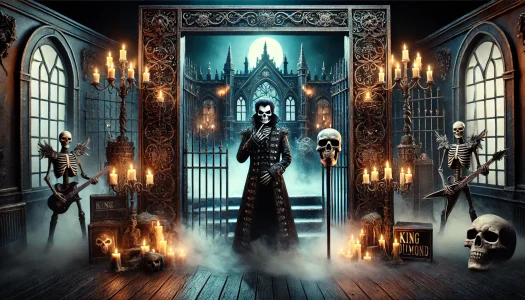King Diamond stands as a monumental figure in metal, recognized for his mastery in blending horror storytelling with the dark allure of heavy metal. Emerging from the Danish metal scene in the late 1970s with his band Mercyful Fate, King Diamond quickly distinguished himself through his distinctive falsetto voice, eerie stage presence, and commitment to horror-laden narratives. As both a solo artist and frontman, his work went beyond mere shock value, introducing concept albums that were true psychological horror sagas—each album a new chapter filled with haunted mansions, supernatural beings, and twisted family secrets.
Origins: King Diamond’s Horror Foundations
King Diamond’s immersion in horror began long before he became one of metal’s most iconic storytellers. Drawn to the occult, supernatural tales, and horror cinema of the 1960s and ’70s, he found early inspiration in everything from classic Gothic literature to the macabre visuals of Hammer horror films. These influences laid the groundwork for his eerie, narrative-driven approach to lyricism, where he crafted songs as chilling short stories rather than straightforward metal anthems. Dark forces, demonic presences, and forbidden rites became staple elements of his storytelling, distinguishing him from the typical themes of the heavy metal landscape.
His first major exploration of these themes came through Mercyful Fate, where albums like Melissa (1983) and Don’t Break the Oath (1984) pushed the boundaries of metal by combining occult motifs with technical, melodic instrumentation. In Melissa, King Diamond introduced listeners to tales of forbidden love twisted by dark magic, while Don’t Break the Oath delved deeper into the demonic and the supernatural, all wrapped in his distinctive blend of falsetto vocals and sinister growls. These albums didn’t just set him apart—they set a new bar for metal lyricism, establishing Mercyful Fate as pioneering figures in the realm of dark, occult-driven metal.
After leaving Mercyful Fate, King Diamond embarked on a solo career that took his horror fascination to a new level. Unlike the episodic nature of his earlier work, his solo albums became immersive concept pieces, with Abigail (1987) marking his first foray into a full-length horror narrative. Here, he didn’t just dabble in occult imagery—he constructed entire worlds of terror, merging his lyrical storytelling with operatic vocal layers and haunting atmospheres.
Concept Albums: Reinventing Horror Narratives in Metal

King Diamond’s concept albums represent a groundbreaking approach in metal, using continuous storytelling to unfold elaborate horror narratives across entire records. With Abigail (1987), Them (1988), and Conspiracy (1989), King Diamond elevated the genre, crafting albums that were as much gothic horror novels as they were collections of songs. Each album tells a cohesive story, meticulously unfolding across tracks with plot development, recurring characters, and shifting settings, creating a sense of immersion rarely seen in heavy metal.
Abigail
In Abigail, King Diamond tells the tale of Jonathan LaFey and his wife, Miriam, who inherit an ancestral mansion haunted by the spirit of a stillborn child, Abigail. Set against a backdrop of Victorian gothic horror, Abigail uses rich, eerie descriptions to pull listeners into its chilling world. Diamond’s vocal techniques, switching between different voices and vocal tones, give life to each character—from Jonathan’s despair to Abigail’s ghostly malevolence. Through ominous narration and haunting melodies, he builds tension with each track, unfolding the tragic fate awaiting the doomed couple.
Them & Conspiracy
In Them and its sequel, Conspiracy, King Diamond moves into more psychological horror territory, drawing listeners into the twisted mind of a young boy haunted by visions of his dead grandmother and an evil entity known as “Them.” This two-part story is marked by intricate character development and plot twists, with King Diamond switching seamlessly between first-person narration and otherworldly voices to express psychological unraveling. With Them, he crafts settings as vivid as any horror film, from the family’s haunted house to the spectral tea parties with unseen entities. These elements give the albums a cinematic quality that drives the horror narrative in ways typically unexplored in metal.
Plot twists further define King Diamond’s horror storytelling. Conspiracy, for instance, takes the psychological unease of Them and twists it into a tale of betrayal and vengeance, heightening the emotional weight and narrative complexity of the story. By using characters with clear motivations, backstories, and distinct arcs, King Diamond’s albums go beyond standard horror themes; they become stories that linger, with listeners drawn back to the music to revisit each eerie detail. Through these concept albums, King Diamond redefined what was possible in metal storytelling, merging horror and music into a form of dark theater that invites listeners into fully-realized worlds of dread and intrigue.
Storytelling Techniques: Atmosphere and Theatricality
King Diamond’s vocal techniques and musical arrangements are essential tools in his horror storytelling arsenal, enabling him to build an atmosphere as intense as any horror film. His distinctive vocal range, from piercing falsettos to deep, menacing growls and whispered narrations, serves as more than a signature style—it’s a way of embodying characters and creating dynamic shifts within his narratives. Each vocal choice reflects the character’s mood or scene’s tension, from the haunting falsetto that conveys supernatural dread to the deep, guttural tones that signal malevolent forces. These techniques help King Diamond conjure the voices of ghosts, demons, and terrified protagonists, immersing listeners in each eerie tale as though they were actors in his horror opera.
King Diamond’s use of spoken word intros and dialogues is another powerful storytelling device that adds a cinematic feel to his music. In albums like Abigail and Them, he opens with chilling narrations that set the scene and build anticipation, like a director setting up a horror film’s prologue. Dialogue sections between characters further enhance this theatricality, allowing King Diamond to shift perspectives and add depth to his plots. Through these exchanges, he brings the listener into the world of each story, often acting out multiple roles himself, morphing his voice to suggest a haunting presence or echoing the internal monologue of a terrified protagonist.
Instrumentals
Instrumentally, King Diamond and his band construct soundscapes that amplify the suspense and dread embedded in his lyrics. Guitar riffs are meticulously timed to underscore dramatic moments, while eerie, winding solos mimic the tension of a horror soundtrack. Drums often build slowly in the background, heightening suspense before breaking into thunderous crescendos that match the storyline’s climaxes. Keyboards, layered with minor chords and ghostly tones, frequently add a spectral quality, creating a haunting ambience that envelops each song. Together, these instrumental arrangements mirror the pacing of horror storytelling, allowing the music to move between ominous quiet and explosive fear, much like a film score.
Visual and Thematic Elements: Crafting a Horror Persona
King Diamond’s horror storytelling goes beyond music—his visual presentation is a critical extension of his terrifying tales. Known for his signature corpse paint, he transforms himself into a ghoulish character with black and white face paint that resembles a skull or demonic figure, depending on the album’s theme. This corpse paint isn’t just for shock value; it’s part of his dedication to immersing the audience in a theatrical horror experience. By embodying his stories visually, King Diamond blurs the line between storyteller and character, becoming a spectral figure who appears to haunt the stage.
His elaborate stage setups reinforce this eerie atmosphere, often featuring Gothic elements like candelabras, iron gates, and mist-shrouded staircases. These sets act as physical extensions of the albums’ narratives, transporting fans to the haunted mansions, shadowy forests, and forgotten gravesites he describes in his lyrics. The hauntingly detailed props—whether an antique wheelchair from Them or the sinister dollhouse of Abigail—are carefully chosen to enhance the storytelling, making the stage an immersive backdrop for his horror tales. Each live show becomes a theatrical performance, where King Diamond takes on the role of both narrator and participant, guiding the audience through the dark worlds of his creation.
Costuming is equally vital to his horror persona. Wearing Victorian-style coats, leather gloves, and occasionally carrying symbolic props like crosses or skulls, he dresses like a figure from an old ghost story. His wardrobe reinforces his connection to the supernatural themes he explores, making him feel like a character who exists outside time, eternally tied to the dark, occult subjects he sings about. Each element, from his corpse paint to his Gothic attire, heightens the drama and psychological impact of his live performances.
Closing Thoughts
King Diamond’s impact on horror storytelling in metal is profound and enduring. By seamlessly merging dark narratives with the sonic power of heavy metal, he redefined what the genre could achieve, turning albums into immersive horror experiences that rival any gothic novel or horror film. Through his intricate concept albums, theatrical stagecraft, and haunting persona, King Diamond not only elevated the art of metal storytelling but also created a lasting blueprint for horror in the genre. He brought complex characters, haunting atmospheres, and supernatural themes to life, pushing the boundaries of heavy metal into realms that few artists had dared to explore.
